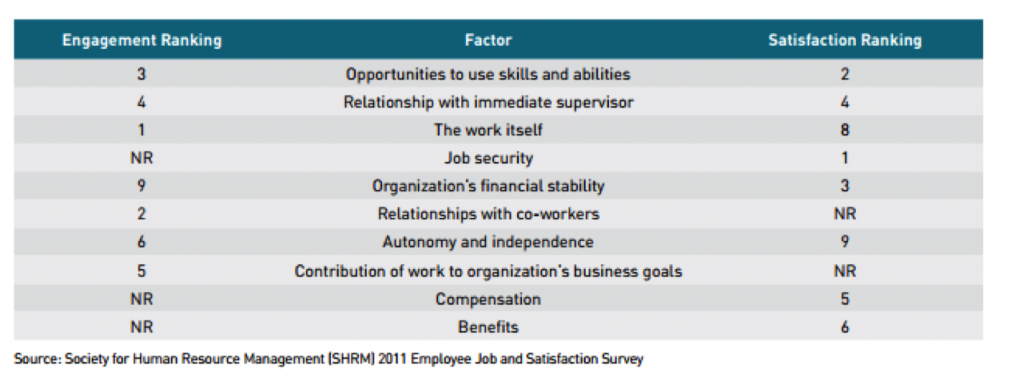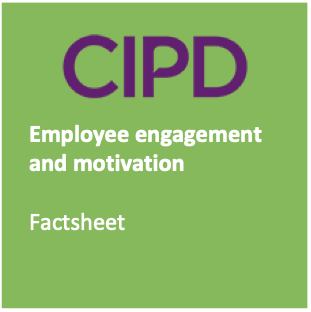learning resources
Defining employee engagement
Overview
Employee engagement is increasingly an area of focus for organisations and their workforce. These learning resources define the term ’employee engagement’ and compares it with a related concept. In the audio clip (to the right) your HR tutor Andrew gives an overview of its purpose and content. Below is a summary of how this fits with the CIPD units.
Version 1.1 – Updated April 2024.
Associate (level 5)
This learning relates to unit 5HR01 – Employment relationship management
AC 1.1 – Review emerging developments to inform approaches to employee voice and engagement.
AC1.3 – Assess a range of employee voice tools and approaches to drive employee engagement.
Advanced (level 7)
This learning relates to unit 7LD01 – Organisational design and development
AC 4.3 – Examine strategies for building employee engagement.
1. What is employee engagement?
Activity
To get you to start thinking about the concept of employee engagement, make a note of the words that spring to mind or words you would relate to engagement.
Why do you think employee engagement is increasingly significant in today’s workplaces? Make a note of your findings.

Employee Engagement defined
As with many other HR and management concepts, there is no one definition of employee engagement. Earlier examples are based on the work of Herzberg and Maslow in the field of motivation. One of the more notable definitions is from Schaufeli and Salanova (2002), who define engagement as:
‘a positive, fulfilling, work- related state of mind that is characterised by vigour, dedication and absorption’.
Schaufeli, W. B., Salanova, M., Gonza ́lez-Roma ́, V., & Bakker, A. B. (2002a). The measurement of engagement and burnout and: a confirmative analytic approach. Journal of Happiness Studies, 3, 71–92.
The Utrecht University group of occupational psychologists outlined the dimensions of this definition, identifying:
- Vigor is characterised by high levels of energy and mental resilience while working, the willingness to invest effort in one’s work, and persistence also in the face of difficulties.
- Dedication is characterised by a sense of significance, enthusiasm, inspiration, pride, and challenge. Vigor and dedication are the direct positive opposites of exhaustion and cynicism, respectively.
- Absorption is characterised by being fully concentrated and happily engrossed in one’s work, whereby time passes quickly and one has difficulties with detaching oneself from work.
An evolving concept…
As the business context changes, along with our understanding of the role of employee engagement, so does the definition of the concept itself. This evolution can be seen in the different definitions of engagement put forward by the CIPD.
In 2011, The CIPD defined employee engagement as:
‘Being focused in what you do (thinking), feeling good about yourself in your role and the organisation (feeling), and acting in a way that demonstrates commitment to the organisational values and objectives (acting).’
This identifies three dimensions:
- Cognitive engagement: focusing very hard on work, thinking about very little else during the working day. It concerns the employees’ beliefs about the organisation, its leaders and working conditions.
- Emotional engagement: being involved emotionally with your work. It concerns how employees feel about each of those three factors and whether they have positive or negative attitudes toward the organisation and its leaders.
- Physical engagement: being willing to ‘go the extra mile’ for your employer and work over and beyond contract. It concerns the physical energies exerted by individuals to accomplish their roles
Here no greater emphasis or importance is placed on any one dimension of engagement. The dimensions are useful because they offer an interesting analysis and classification of the types of behaviours that feed into engagement and how these impact on the overall engagement levels.
In 2013, the CIPD updated its definition stating that engagement is about:
‘Being focused in what you do (thinking), feeling good about yourself in your role and the organisation (feeling), and acting in a way that demonstrates commitment to the organisational values and objectives (acting).’
Whilst the three dimensions remain, their wording is refined:
- Intellectual engagement: thinking hard about the job and how to do it better
- Affective engagement: feeling positively about doing a good job
- Social engagement: actively taking opportunities to discuss work-related improvements with others at work.
CIPD (2011) Management Competencies for Enhancing Employee Engagement, CIPD [Online]. Available at: http://www.cipd.co.uk/hr-resources/research/management-competencies-for-engagement.aspx (Accessed: 11 November 2014).
CIPD (2013) Factsheet: Employee engagement, CIPD [Online]. Available at: http://www.cipd.co.uk/hr-resources/factsheets/employee-engagement.aspx (Accessed: 11 November 2014).
Activity
To help your understanding of the dimensions of engagement, think about the extent to which you are engaged with your work on an intellectual, affective and social level. What behaviours do you demonstrate, either positive or negative?
Make a note of your thoughts.

Engagement – is it the same as happiness?
People often associate an engaged workforce with one that is happy. Is happiness the same as engagement though, and does one lead to the other?
Activity
The link on the left takes you to the article Employee Engagement Doesn’t Equal Employee Happiness. The article states that this is a false assumption. Read the article and make a note of your thoughts on the subject.
Once you’ve done this, listen to what Andrew has to say.
2. Job satisfaction
Job satisfaction defined
Job satisfaction is a complex and multifaceted concept which can mean different things to different people. The concept of job satisfaction is closely linked to that of engagement. Here we can see a definition offered by Armstrong (2009) who explained that it:
‘refers to the attitudes and feelings people have about their work. Positive and favourable attitudes towards the job lead to engagement and therefore job satisfaction. Negative and unfavourable attitudes towards the job indicate job dissatisfaction.’
While the definitions of employee satisfaction and employee engagement may differ from organisation to organisation, generally satisfaction refers to how employees feel — their ‘happiness’— about their job and conditions, such as compensation, benefits, work environment, and career development opportunities.
The level of job satisfaction is affected by intrinsic and extrinsic motivating factors, the quality of supervision, social relationships with the work group and the degree to which individuals succeed or fail in their work.
Armstrong, M. (2009) Armstrong’s Handbook of Human Resource Management Practice, 11th edn, London, Kogan Page.
Activity
Can an organisation have a satisfied employee who is not engaged and vice versa? What do you think?
Make a note you your thoughts.
Engagement refers to employees’ commitment and connection to work as measured by the amount of discretionary effort they are willing to expend on behalf of their employer. Highly engaged employees go above and beyond the core responsibilities outlined in their job descriptions, innovating and thinking outside the box to move their organisations forward.
Chances are an engaged employee is also a satisfied employee; few people are willing to go the extra mile for their employer unless they are fundamentally happy in their jobs. However, it is certainly possible to have a satisfied employee with a low engagement level — someone who shows up to work and goes through the motions, but does not demonstrate a lot of initiative or put in a lot of extra effort to further the success of the organisation.
Drivers
The table on the right shows the drivers that received top rankings for both satisfaction and engagement among the Society for Human Resource Management (SHRM) 2011 Employee Job Satisfaction and Engagement Survey.
The table shows the smallest spread between satisfaction and engagement rankings for the following factors:
- Relationship with immediate supervisor
- Opportunities to use skills and abilities
- Autonomy and independence
These findings suggest that HR focus in these areas may have a positive impact on both satisfaction and engagement levels, thereby potentially driving higher overall performance and bottom-line results.



